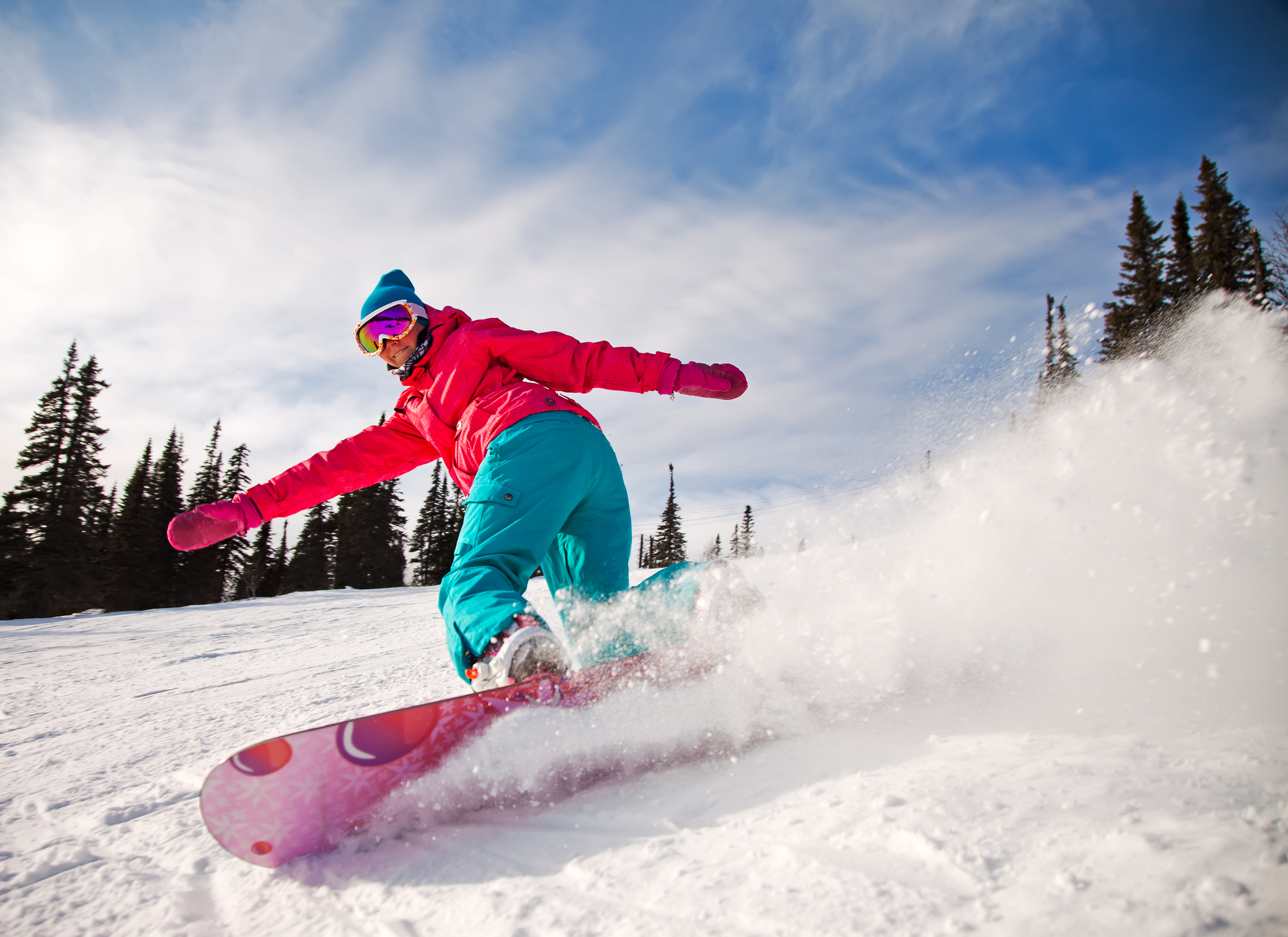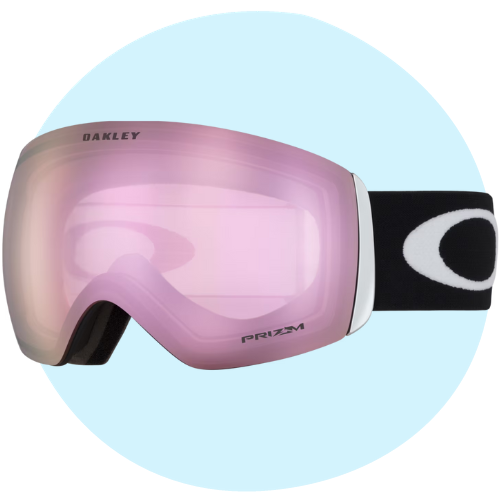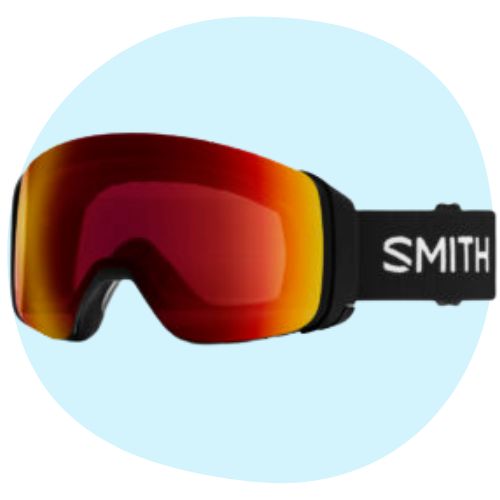Updated on April 29, 2025
8 Best Ski Goggles When Hitting the Slopes in 2025


Vision Center is funded by our readers. We may earn commissions if you purchase something via one of our links.
Everything We Recommend

Ski goggles are an essential part of skiing. They help protect your eyes and improve your vision in challenging weather conditions.
But not all ski goggles are created equal. Some ski goggles have more features than others, and others are equipped with features suitable for specific needs.
Let’s look at some of the top ski goggles options for your next trip to the snowy mountains.
Why Trust Us?
Vision Center aims to provide comprehensive and unbiased reviews of different products and services. For this review article, we did the following to ensure helpful reviews:
- Compared the top ski goggle brands on the market, carefully reviewing their features and offerings
- Spoke to top professionals in the industry to know more about the importance of ski goggles and what features to look for
- Reviewed customer feedback about different ski goggles to learn more about their experience with the product
- Rated each recommended product based on its overall performance, comfort, cost, and quality
- Read contemporary scholarly articles about the latest updates in vision health and ski equipment
All of our articles go through a rigorous editing process to ensure all the information is factual. We also have a team of medical reviewers to guarantee that our articles are medically accurate.
Where to Buy Glasses + Contacts
Best Overall: Warby Parker
Fastest Delivery: EyeBuyDirect
Also Great: Liingo
Best Place to Buy Contacts: Discount Contacts
8 Best Ski Goggles of 2024
Here are our top recommendations for ski goggles:
Best Overall – Smith 4D MAG

Our top overall recommendation for ski goggles is Smith’s 4D MAG. These goggles offer premium features and sleek designs that make them stand out.
Some top features of these goggles include:
- Uses magnets for a quick and easy lens switch
- Ultra-wide, silicone-backed strap to help keep the goggles in place
- ChromaPop™ lenses available to enhance contrast and natural color
- 100% protection from UV rays
Cost
Smith Optic’s 4D MAG ski goggles cost around $270 to $320 per pair. You can check Smith’s website to score deals and discounts.
Pros and Cons
Here’s what we like and don’t like about Smith Optic’s 4D MAG ski goggles:
What we like:
- ChromaPop™ lens technology sets these ski goggles apart since they provide exceptional clarity, definition, and color contrast to enhance visibility on the slopes
- Smith’s 4D MAG goggles are generally more comfortable for extended wear
- The goggles are well-designed, and you can choose from various styles and designs to suit your personal style
What we don’t like:
- The goggles are a bit on the expensive side, with prices starting a little under $300
- Spare lenses are also quite pricey, which can be an additional expense
What Customers Are Saying
Here’s what customers are saying about these ski goggles:
- The goggles improved their skiing performance since they helped them see while in the mountains
- Customers experienced an excellent field of view while wearing these ski goggles
- A few customers experienced quality issues, with some goggle parts coming off easily
- Others received incomplete orders, such as the missing goggle bag
Best for Peripheral Vision – Giro Contour Goggle

We chose Giro’s Contour Goggle for this category because it offers an excellent toric lens design. Toric lenses have a lens shape that provides a wide field of view for better peripheral vision.
Some top features of Giro’s Contour Goggle include:
- Expansion View technology to help keep the goggles out of your peripheral vision
- Offers a new toric lens shape and VIVID lenses with Optics by ZEISS
- EVAK vent system to prevent fogging
- Frameless design for a sleeker look
Cost
Giro’s Contour Goggle is available at different price points. They range from $202.45 to $270.00.
Pros and Cons
Here’s what we like and don’t like about Giro’s Contour Goggle:
What we like:
- The ski goggles have great optics that provide excellent clarity and visual quality
- You can achieve a wide field of view due to the toric lens
- Giro’s ski goggles are compatible with their helmets, so they’re a good choice if you also use Giro’s helmets
What we don’t like:
- Extra lenses are also on the pricier side, so you have to spend more money if you want to change them
- The original Contour goggles are quite large, but you can opt for Contour RS if you have a smaller face
What Customers Are Saying
Here’s what customers are saying about Giro’s Contour Goggle:
- The goggles provide a great field of view when skiing thanks to their Expansion View technology
- Giro’s Contour Goggle has a good lens change system, so you can easily switch out the lenses
- Some customers don’t feel satisfied with their purchase, especially because the goggles are on the pricier side
- Giro’s glasses may have some durability issues, so they might not be the best option for long-term use
Best Anti-Fog Performance – Salomon Radium Pro Sigma

Salomon’s Radium Pro Sigma offers top-of-the-line ventilation for anti-fog performance. This makes the glasses an excellent option for those looking for a long, fog-free experience on the slopes.
Some top features of the Salomon Radium Pro Sigma include:
- An easy lens change system that allows you to switch between lenses quickly
- Spherical lens that helps improve your vision and minimize distortion
- The lens has Anti Fog + technology, which is four times more fog resistant than the standard lens
- Compatibility with Salomon’s Husk helmet for easy wear
Cost
Salomon’s Radium Pro Sigma goggles range from $149.95 to $200. The cost will depend on your chosen style and any additional lenses.
Pros and Cons
Here’s what we like and dislike about the Salomon Radium Pro Sigma:
What we like:
- The goggles offer great protection and technology at a lower price compared to other premium goggles on the market
- Salomon’s Radium Pro Sigma is well-ventilated, so they don’t fog, making skiing more comfortable
- It offers good color contrast while you’re on the slopes, mainly because of its SIGMA™ lens
What we don’t like:
- The goggles are a bit uncomfortable when worn, so you have to adjust them constantly
- It’s not a great fit for different face sizes and shapes
What Customers Are Saying
Here’s what customers are saying about the Salomon Radium Pro Sigma goggles:
- Many customers like how the goggles don’t easily fog up during long skiing sessions
- The goggles offer a great field of vision, which makes their skiing experience more enjoyable
- Most of the customer complaints come from how the goggles are uncomfortable and don’t fit their face well
Best Impact Resistance – POC Nexal Clarity Goggles

POC’s Nexal Clarity Goggles are our choice for the best impact resistance. They’re equipped with Zygomatic Bone, which offers more cushioning and skiing protection.
These goggles also have features like:
- A triple-layer face foam that helps reduce impact while skiing
- Cylindrical lenses that are distortion-free so that your field of view stays good
- Anti-dirt and anti-scratch treatment that helps your goggles stay wearable for a longer time
- Ventilation toggle that can improve airflow while skiing
Cost
The POC Nexal Clarity ski goggles retail for $230. You can also score these goggles for an outlet sale price of $115.
Pros and Cons
Here’s what we like and don’t like about the POC Nexal Clarity Goggles:
What we like:
- We’re impressed with the added protection since it makes you feel safer while skiing
- It’s very comfortable because of the triple-layer cushioning around the frames
- The goggles have extra features and innovative designs that make them worth the price
What we don’t like:
- The goggles are generally on the more expensive side, but it’s good that you can still get them for an outlet sale price
- Switching between lenses can be difficult
- Lens options are limited compared to other ski goggle brands
What Customers Are Saying
Here’s what customers are saying about POC’s Nexal Clarity:
- The goggles offer a great fit, and they’re generally comfortable to wear
- Nexal Clarity provides a good field of view that doesn’t interfere with skiing
- POC’s Nexal Clarity goggles can be pricey for some buyers, mainly because there are no spare lenses included.
Best for Prescription Wearers – Bollé Supreme OTG

People who wear prescription glasses may find it challenging to use generic ski goggles. As such, they need to find Over the Glasses (OTG) goggle options.
Our top recommendation for OTG goggles is Bollé’s Supreme OTG. Bolle ski goggles offer:
- Convenient OTG design for prescription glasses wearers
- Double-density medium foam with a soft and comfortable micro-fleece layer
- Premium anti-fog features
- Protective armor lens coating that reduces scratches and other damage
Cost
The Supreme OTG ski goggles cost around $120 to $220. They also offer discounts, where you can purchase the goggles for as low as $72.
Pros and Cons
Here’s what we like and don’t like about the Bollé Supreme OTG ski goggles:
What we like:
- The OTG fit makes it an excellent choice for those who need to wear eyeglasses while skiing
- Despite the OTG fit, the goggles still fit comfortably even if you aren’t wearing eyeglasses underneath
- They come at affordable prices, with deals making the goggles less than a hundred dollars
What we don’t like:
- They only have limited styles of goggles to choose from
- There isn’t much added technology or features, but it’s understandable due to its pricepoint
What Customers Are Saying
Here’s what customers are saying about these ski goggles:
- The goggles offer a comfortable fit even while you’re wearing eyeglasses
- One customer pointed out that the lenses can quickly adapt from bright to low-light conditions, so you don’t have to worry about always changing them
- A few customers have experienced shipping problems when ordering their goggles from Bollé’s store
Best Styles and Designs – Oakley Flight Deck™ L Snow Goggles

If you’re looking for a range of styles and designs, look no further than Oakley. Their Flight Deck™ L Snow Goggles come in 33 different colors and tints.
Different lens tints also serve different purposes, so having multiple options is beneficial.
Other features of Oakley’s Flight Deck L™ Snow Goggles include:
- Equipped with Prizm™ Lens Technology that helps enhance contrast and color while skiing
- Has a Flexible O Matter® chassis so that the goggles fit your face more comfortably
- Can be compatible with most prescription eyewear because of the discreet frame notches
Cost
Oakley’s website lists the Flight Deck L™collection for $216.00 each. However, you can browse online retailers like Amazon for lower prices.
Pros and Cons
Here’s what we like and dislike about Oakley’s Flight Deck L™ Snow Goggles:
What we like:
- The rimless frame makes it a timeless and stylish option that goes well with any ski outfit
- You have more than 30 styles of goggles and lenses available
- Good lens quality that offers 100% protection from UVA/UVB/UVC and blue light
What we don’t like:
- The goggles are only available in a large size, so it’s not the best option for people with small faces
- It’s not easy to change out the lenses for these goggles compared to other brands
What Customers Are Saying
Here’s what customers have to say about Oakley’s Flight Deck L™ Snow Goggles:
- Many customers rave about the excellent peripheral vision while wearing these goggles
- The goggles offer a good field of vision, whether it’s sunny or cloudy outside
- Some have experienced difficulty when changing the lenses for the first time
- Others say that they experienced bad fogging while wearing the glasses, disrupting their skiing experience.
Best Fit and Comfort – Smith I / O Mag

Smith’s I / O MAG Goggles win the best fit and comfort category. They’re made with a triple-layer foam construction, so the goggles don't pinch or cause discomfort when worn.
Some of the features of these goggles are:
- A three-layer DriWix face foam that wicks moisture and helps the goggles stay in place
- MAG lens change system that allows you to quickly and easily change your lenses
- Adjustable QuickFit strap so you can easily find the right fit
- Designed to integrate with Smith helmets for a more secure fit
Cost
These goggles are available for $270. Payment options like Afterpay are available so that you can pay in installments.
Pros and Cons
Here’s what we like and don’t like about the Smith I / O MAG Goggles:
What we like:
- The design is well thought out, so it fits comfortably around your head and helmet
- It comes with two lenses: bright light and low light ChromaPop™ performance tints
- Smith is a big name when it comes to ski goggles, so you can ensure quality products from them
What we don’t like:
- These goggles aren’t budget-friendly since they come at a high price point
- They can become foggy during use
What Customers Are Saying
This is what customers have to say about these ski goggles:
- Many customers like how the ski goggles fit since they can easily adapt to your face shape
- It’s easy to switch out lenses, thanks to the MAG feature
- Some customers have experienced incomplete or damaged orders
- There are a few customers who also complained about fogging issues while wearing the goggles
Best Budget-Friendly Option – SunGod Vanguards

Finally, if you’re looking for a budget-friendly pair of ski goggles, choose SunGod’s Vanguards. They’re available at a starting price of $160.
Here are some features of the SunGod Vanguards:
- Made with 8KO technology, which is the industry’s leading nylon technology, so you can have optimal clarity while skiing
- Large cylindrical lens that offers maximum peripheral vision
- Lifetime guarantee (they’ll repair your goggles free of charge if they break)
Cost
SunGod Vanguards are available at $160. This is a good price, considering the goggles are equipped with advanced technology.
Pros and Cons
Here’s what we like and don’t like about SunGod’s Vanguards:
What we like:
- You get an excellent pair of ski goggles at a fair price point
- There’s an option to customize your goggles on the website, and you can choose from 8 different tint options
- The lifetime guarantee makes the price tag even more worth it
What we don’t like:
- The goggles have a bit of a bigger fit than other ones on the market
- Their designs aren’t as versatile or timeless compared to other big brands
What Customers Are Saying
Here’s what customers are saying about SunGod’s Vanguards:
- The goggles offer good vision in different light levels, so it’s easy to see your surroundings
- A few reviews noted that they received freebies like an extra strap with their order
- Some customers experience quality issues with the product they’ve received
- Others find it difficult to reach out to customer service representatives, especially if they need repairs
Why Do You Need Ski Goggles?
Ski goggles are among the most important purchases when assembling your ski gear collection. They play a role in your ability to ski safely and have a comfortable and enjoyable experience.
There are several reasons why ski goggles are essential:
Protection from the Cold
Ski goggles protect your eyes from the cold and wind. Not only is skiing down a hill unpleasant with exposed eyes, but it’s also dangerous.
Ski goggles seal on the face and create a barrier from the elements, making your skiing experience much more pleasant.
Protection from the Sun
Ski goggles are usually made with UV-resistant lenses to keep your eyes safe from the sun. This is an issue that involves both safety and comfort since your eyes need protection from sun exposure.
In addition, sun glaring off the white snow doesn’t make for a pleasant skiing experience. The glare forces you to squint, affecting your ability to see.
Enhancing Visibility
Ski goggles also enhance the visibility of your surroundings. They reduce glare while skiing since they have mirrored or polarized lenses. Specific lens tints or coatings also enhance contrast.
Other reasons you’ll want to invest in a quality pair of ski goggles include:
- Higher contrast, even in a bright environment
- An additional layer of warmth to protect your face
- More protection for the unpredictable things that might occur when skiing, such as flying debris or falls
How to Choose the Best Ski Goggles
There are several things to consider when shopping for the best ski goggles. For example:
1. Anti-Fog Features
Condensation is a problem for anyone wearing an eye covering, especially when it’s cold.
It occurs because your warm breath blows upward and condenses on the cold surface of the goggles. People wear goggles when skiing because they have less risk than sunglasses for fogging.
Anti-fog coating makes your skiing experience more enjoyable. You don’t have to wipe away condensation from your goggles constantly.
In addition, anti-fog coating makes skiing safer since it lets you see your surroundings clearly.
2. Scratch-Resistant Coating
Your goggles should feature a scratch-resistant coating that prevents damage. You’ll get more wear from a pair of goggles featuring scratch-resistant coating.
This coating isn’t foolproof, though. However, it will reduce many scratches from minor mishaps, such as dropping your goggles or debris impact.
3. UV Protection
Like sunglasses, ski goggles usually feature UV protection. Make sure any pair of goggles you purchase offers UV sun protection unless you’re wearing sunglasses under the goggles.
Doubling up on UV protection doesn’t hurt, though. Goggles with a minimum filter category of three offer the best protection.
Kids are more susceptible to UV exposure than adults, so category 3 for kids is also recommended. For adults and kids, category 2 would be acceptable in low-light conditions.
4. Frame Size and Shape
Choosing goggles with the right frame size and shape for your face and your needs is essential. Frames too small or too large interfere with your visual ability when skiing.
The two main frame shapes for ski goggles are cylindrical and spherical:
Cylindrical Lenses
Cylindrical lenses curve across from the left to the right side of the goggles and are flat between the forehead and nose. They tend to fog more and not reflect glare as efficiently as spherical lenses. Some people also find their peripheral vision lacking with these lenses.
Spherical Lenses
Spherical lenses are rounded on the vertical and horizontal axis and have a bubbled appearance. With these goggles, you get better glare and UV protection, and your goggles are less likely to fog. You also get an “optically correct” view without distortion and with maximum peripheral vision.
5. Peripheral Vision
Quality ski goggles allow you to see 180 degrees from side to side. As mentioned above, spherical lenses offer the best peripheral vision.
You can also benefit from toric lenses. Toric lenses are curved in two directions, which allows you to see more of your surroundings.
6. Photochromic Technology
Photochromic lenses adjust automatically based on light conditions. The level of UV exposure triggers the lens to get lighter or darker based on brightness.
Choosing goggles with a photochromic lens means you benefit from having a single lens that can adapt to various situations. You don’t need to have different goggles for different levels of brightness.
8. Interchangeable Lenses
Interchangeable lenses are a common feature in modern ski goggles. Most goggles come with two sets of lenses, one for bright conditions and one for low light. This means you’ll always have perfect eyewear regardless of the brightness level.
Some people prefer single-lenses goggles because they don’t need to worry about switching or keeping track of multiple lenses. In most cases, single lenses are “good enough,” but you’ll never have precisely perfect goggles for different weather conditions.
9. Warranty
Choosing a pair of ski goggles with a reliable warranty is important if you invest in higher-end goggles. Any time you spend a decent amount of money on a product, you want protection. Most of the well-known ski goggles brands offer a warranty.
Types of Ski Goggle Lens Tints
The tint of your goggle lenses affects your ability to see and be comfortable when skiing.
Tint has a significant impact on visibility, so it’s best to sample different options and consider the weather conditions where you most often ski.
Lens tints include:
- Clear. Extremely low-light conditions, such as night skiing
- Pink or rose. Low-to-mid light conditions, such as overcast or partly cloudy days, dawn, or dusk skiing
- Yellow. Snowy conditions because they filter blue light and sharpen the field of vision (these also work on sunny days and are the best all-around goggle tint if you only have one tint)
- Amber or orange. Overcast conditions, as well as fog because they increase shadow definition (these are also good all-around glasses that work in most conditions)
- Black. Brightest conditions and offer optimal UV protection
- Brown or bronze. Bright conditions and increase depth perception and contrast
- Red. Medium to bright light conditions and they increase sharpness and definition
- Green. Medium to bright condition, increase depth perception, and reduce eye fatigue
- Blue. Low-light conditions (unless mirrored) that cut glare
- Violet. Low-to-moderate light conditions offer natural color perception, and make it easier to see bumps, ice patches, etc.
Summary
Ski goggles are an important piece of gear for any skier. With the right lens type, you can get the best performance out of your goggles and ensure optimal visibility and comfort on the slopes.
Our list can guide you in the right direction when choosing the best ski goggles. Remember that different lenses are best for different conditions. You may need more than one lens type to maximize your comfort and performance while skiing.
In this article
7 sources cited
Updated on April 29, 2025
Updated on April 29, 2025
About Our Contributors
Mara Sugue, with a B.A. in Social Sciences, is a dedicated web content writer for Vision Center. She is committed to making eye health research accessible and understandable to people from diverse backgrounds and educational levels. Her writing aims to bridge the gap between complex vision health topics and readers' needs for clear, factual information.
Dr. Melody Huang is an optometrist and freelance health writer with a passion for educating people about eye health. With her unique blend of clinical expertise and writing skills, Dr. Huang seeks to guide individuals towards healthier and happier lives. Her interests extend to Eastern medicine and integrative healthcare approaches. Outside of work, she enjoys exploring new skincare products, experimenting with food recipes, and spending time with her adopted cats.







